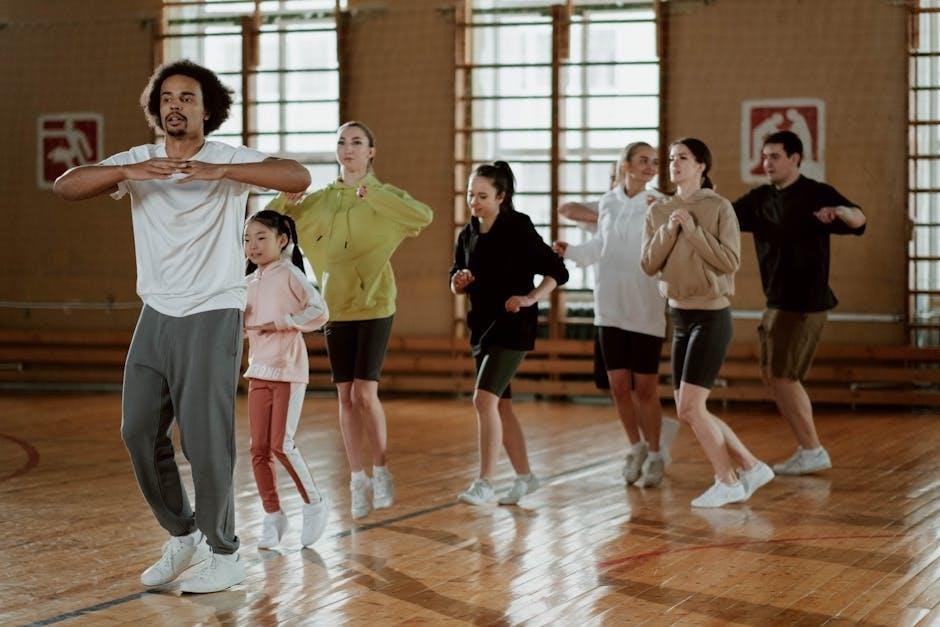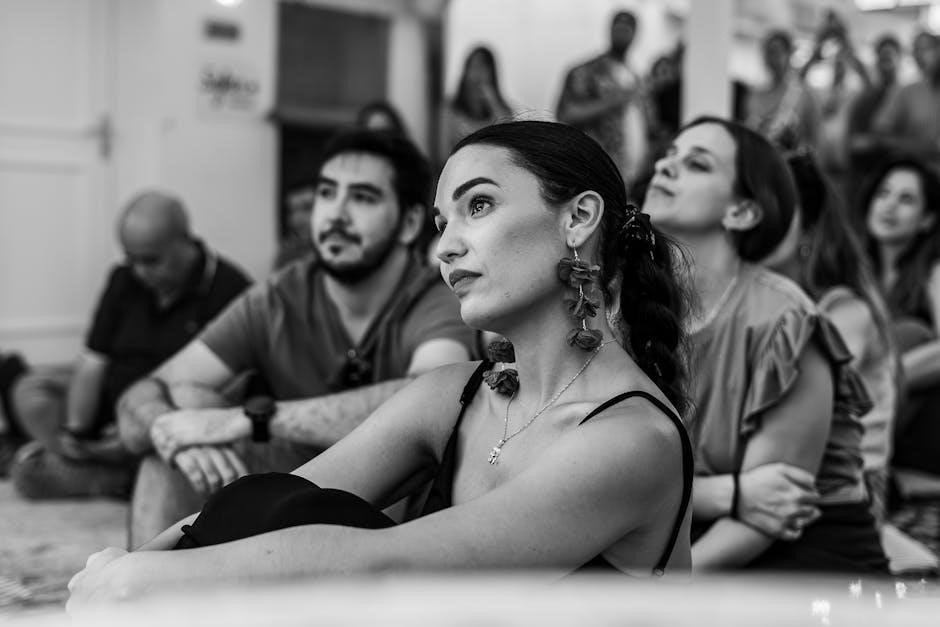Listen and draw activities offer a unique blend of skill enhancement and creative fun for adults. These activities involve listening to instructions and creating a drawing based solely on the verbal descriptions.
What are Listen and Draw Activities?
Listen and draw activities are engaging exercises that combine auditory processing with artistic expression. Participants listen to a set of instructions and simultaneously create a drawing based on what they hear. The challenge lies in accurately interpreting the verbal cues and translating them into visual form. These activities require active listening, concentration, and the ability to filter out distractions. They differ from traditional art classes as the focus is on following directions rather than artistic skill. The goal is to accurately represent the instructions through drawing, fostering both listening comprehension and creative interpretation;

Benefits of Listen and Draw Activities for Adults
Listen and draw activities for adults provide numerous benefits, including enhanced listening skills, improved focus, boosted creativity, and effective communication. These activities also promote relaxation and reduce stress.
Enhancing Listening Skills
Listen and draw activities are excellent for honing active listening skills in adults. Participants must carefully attend to spoken instructions, process the information, and translate it into visual form. This process necessitates focus and concentration, effectively training the brain to filter distractions and retain details.
By engaging in these activities, adults learn to discern crucial information from background noise, improving their ability to follow complex directions. The need to accurately interpret instructions enhances comprehension and memory, leading to better overall listening proficiency. This skill is invaluable in various professional and personal settings, fostering clear communication and understanding.
Boosting Creativity and Imagination
Listen and draw activities serve as a powerful catalyst for boosting creativity and imagination in adults. With only verbal instructions as a guide, participants are encouraged to visualize and interpret information in their own unique way. This process ignites the imagination, pushing individuals beyond their comfort zones.
The absence of visual aids allows adults to freely explore different artistic interpretations, fostering innovative thinking and problem-solving skills. By transforming abstract concepts into tangible drawings, participants unlock their creative potential and develop a stronger sense of artistic expression. This imaginative exercise extends beyond the activity, influencing their approach to everyday challenges.
Improving Communication
Listen and draw activities significantly improve communication skills in adults, offering a unique approach to active listening and clear instruction-giving. As participants listen intently to verbal descriptions, they learn to filter out distractions and focus on key details. This sharpens their ability to comprehend complex information and translate it into visual representations.
Moreover, these activities enhance the clarity of communication. When providing instructions, individuals must articulate their ideas precisely and concisely to ensure accurate drawings. This fosters effective verbal communication, promoting clarity and reducing misunderstandings. The shared experience encourages constructive feedback and collaborative problem-solving, further strengthening communication bonds.
Stress Reduction and Relaxation
Engaging in listen and draw activities offers a calming escape from the pressures of daily life, promoting stress reduction and relaxation for adults. The focused nature of listening and drawing encourages mindfulness, allowing individuals to immerse themselves in the present moment and quiet mental chatter. As participants concentrate on the instructions and translate them into visual form, they enter a state of flow, where worries fade into the background.
The creative process itself is inherently therapeutic, providing a healthy outlet for emotions and fostering a sense of accomplishment. The absence of pressure to create a perfect artwork further enhances relaxation, emphasizing the enjoyment of the process over the final product. This fosters a lighthearted and enjoyable environment.

Types of Listen and Draw Activities
Listen and draw activities come in diverse forms, each presenting unique challenges and engagement opportunities. These types include geometric design instructions, descriptive image instructions, and story-based drawing scenarios for adults.
Geometric Design Instructions
Geometric design instructions in listen and draw activities involve participants creating abstract patterns. The speaker provides specific instructions to draw different shapes, sizes, and their placement. For instance, “Draw a large circle in the center, then add a small square in the upper right quadrant.”
Participants must focus on accurate shapes and spatial relationships. The instructions could become increasingly complex, like, “Draw a line from the top of the square to the bottom of the circle, bisecting the design.” These activities test precision and the ability to follow sequential instructions. The result is often a unique geometric composition.
Descriptive Image Instructions
Descriptive image instructions are a type of listen and draw activity where participants create pictures based on verbal descriptions. The instructor describes a scene, object, or character in detail, and the participants attempt to draw what they hear. For example, “Draw a house with a red roof, a blue door, and two windows.”
These instructions test the ability to visualize and translate verbal cues into visual representations. Unlike geometric designs, descriptive images require a degree of interpretation and artistic license. The instructions may include details about the environment, lighting, and perspective.
Story-Based Drawing
Story-based drawing takes the listen and draw concept a step further by integrating it with narrative. Instead of simple descriptions, participants listen to a short story or a scene from a story and draw what they visualize.
This activity encourages imaginative thinking and active listening, as participants must translate the narrative into visual form. Instructions might include, “Draw the dragon’s lair as described in the story,” or “Illustrate the moment when the hero confronts the villain.” Story-based drawing prompts creativity and allows for diverse interpretations of the same narrative.

How to Conduct a Listen and Draw Activity
Conducting a listen and draw activity involves thoughtful planning. Clear and concise instructions are essential for success. Provide supportive feedback to encourage participants’ creativity and boost their confidence in the activity.
Setting Clear Instructions
When initiating a listen and draw activity, the clarity of instructions is paramount. Begin by outlining the scope and objectives of the drawing. Use precise and unambiguous language to describe shapes, sizes, positions, and relationships between elements. Break down complex images into simpler steps.
Consider providing a sample instruction set before the actual activity to familiarize participants with the process. Avoid jargon or overly technical terms that may cause confusion; Maintain a steady and deliberate pace while delivering instructions, allowing ample time for participants to process and translate the words into visual representations on paper. This ensures everyone can follow along effectively.
Providing Feedback and Encouragement
After a listen and draw activity, providing constructive feedback and positive encouragement is essential for fostering growth and enjoyment. Begin by acknowledging effort and creativity, regardless of the outcome. Focus on specific aspects of the drawings, highlighting accurate interpretations of instructions or unique artistic choices.
Offer suggestions for improvement in a supportive manner, focusing on areas where instructions may have been misinterpreted or where details could be enhanced. Emphasize that the goal is not perfection, but rather the development of listening skills and creative expression. Create a safe and non-judgmental environment where participants feel comfortable sharing their work and learning from each other’s experiences.

Variations and Adaptations
Listen and draw activities can be adapted to suit different skill levels and interests. Variations include group drawings, themed instructions, and incorporating different art mediums for enhanced engagement and creative exploration.
Group Listen and Draw
Group listen and draw activities foster collaboration and communication skills. In this variation, a single set of instructions is given to a group of participants. Each member contributes to a shared drawing, either on a single large sheet or individual sections that combine later. This encourages active listening as participants must interpret instructions collectively.
The challenge lies in coordinating individual interpretations to create a cohesive final image. Groups learn to negotiate, clarify, and adapt their drawings based on others’ contributions. It can also highlight different perspectives and problem-solving approaches within the group setting, promoting teamwork and understanding.
The Back-to-Back Drawing Exercise
The back-to-back drawing exercise is a powerful communication tool. Participants pair up, sitting back-to-back. One person receives an image and must describe it verbally to their partner, who attempts to recreate the image based solely on the description. The catch? No questions or visual cues are allowed during the process.
This activity highlights the challenges of clear and effective communication. The speaker learns to articulate detailed descriptions, considering perspective and spatial relationships. Meanwhile, the listener must actively interpret and visualize the information, coping with ambiguity and potential misunderstandings. Upon completion, comparing the original image with the drawing reveals communication gaps.
